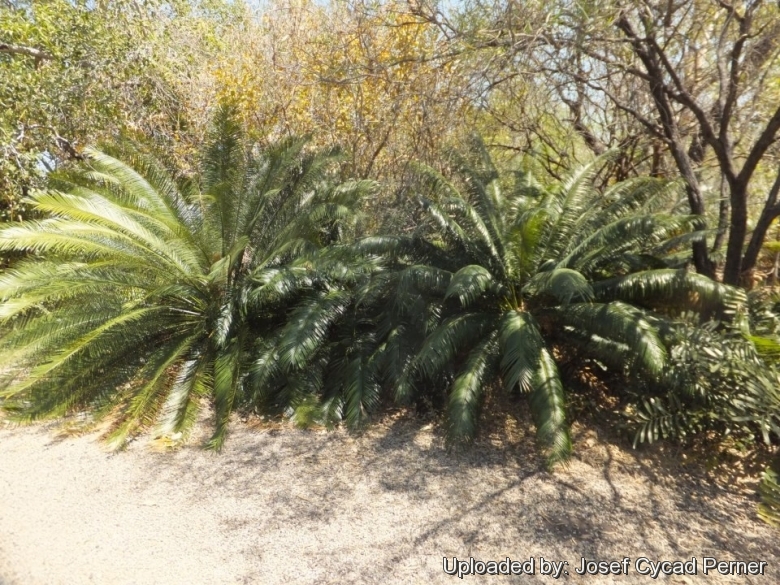
Cycas tansachana Photo by: Josef Cycad Perner
This was grown from seeds that I collected from Habitat on Cycad Research Expedition with Ken Hill.
Origin and Habitat: Cycas tansachanaSN|29483]]SN|29483]] is a treelike cycad endemic to south central Thailand, occurring to the north east of Khong Khi Sua in Sariburi Province, about 100 Km North of Bangkok. It is known only from a single location, but plants are relatively abundant (2,500 to 10,000 mature individuals) but very restricted in their distribution (area of occupancy and extent of occurrence less than 10 km²).
Altitude range: Occurs at an elevation of 400 metres above sea level.
Habitat and Ecology: This species grows on limestone outcrops growing in full sun or partial shade in crevices on bare rock. The limestone outcrops are covered with sparse, seasonally deciduous forest. This species is apparently quite restricted in occurrence and has declined dramatically due to mining of limestone for the making of cement. At one stage it was thought to be Extinct in the Wild after limestone outcrops were destroyed, but was subsequently found on adjacent outcrops and is still under severe pressure from plant collectors and limestone mining operations.
Synonyms:
Description: Cycas tansachana is one of Thailands rarest cycads and has only been scientifically described a few years ago. It is a tough and rugged looking tree like cycad (one of the largest cycads) with a rather narrow trunks with yellowish-grey bark, that fork in older plants. It can reach up to 7 m, with many branches and large base up to 1 m wide. Has fine leaflets arranged in a flat plane along the rachis, but in older leaves, tend to hang down just below the rachis a bit giving it a soft, friendly look. The seeds are quite large.
Distinguishing features: This species is similar to Cycas clivicolaSN|31991]]SN|31991]] in many respects, differing in the larger and distinctly keeled leaves with stiffer, broader leaflets, and the larger male cones, megasporophylls and seeds. The bark is also somewhat thicker and more corky, and the crown of orange wool around newly developed cataphylls is not seen in any other Thai species.
Derivation of specific name: It was named after Kampon Tansacha, of the Nong nooch Tropical Gardens, Thailand, who helped in its discovery. Historical notes: Discovered in 1995.
Stems: Arborescent, to 2-5(-7) m tall, 10-18 cm diameter at narrowest point and with a large base up to 1 m wide; 24-60 leaves in crown.
Leaves (fronds): Deep green, semiglossy, 100-180 cm long, moderately keeled (opposing leaflets inserted at 90-140° on rachis), with 130-200 leaflets, with white tomentum shedding as leaf expands; rachis frequently terminated by a spine 1-3 mm long. Petiole 30-45 cm long (20-30% of total leaf), petiole glabrous, unarmed or spinescent for 0-30% of length. Basal leaflets not gradually reducing to spines, 80-160 mm long. Median leaflets simple, strongly discolorous, 170-300 mm long, 8-12.5 mm wide, inserted at 60-70° to rachis, decurrent for 3-5 mm, narrowed to 2.5-4 mm at base (to 25-45% of maximum width), 10-17 mm apart on rachis; median leaflets section flat; margins slightly recurved; apex acute, not spinescent; midrib flat above to raised above (slightly), raised below.
Cataphylls: The cataphylls (Modified leaf, much reduced and thickened, serving to protect the apical meristem in cycads produced in flushes preceding the emergence of cones or leaves.) are narrowly triangular, soft, pilose, 50-60 mm long, persistent.
Male cones: Narrowly ovoid, yellow, 25-45 cm long, 11-13 cm diam.; microsporophyll lamina firm, not dorsiventrally thickened, 33-45 mm long, 12-15 mm wide, fertile zone 27-40 mm long, sterile apex 6-15 mm long, level, apical spine prominent, sharply upturned, 1-3 mm long.
Megasporophylls: Like other Cycas species, the female plants do not bear cones; instead they carry ovules and seeds on large, yellow-tomentose to brown-tomentose megasporophylls which are 20-22 cm long; ovules 2-4, glabrous; lamina orbicular, 100-140 mm long, 60-70 mm wide, deeply pectinate, with 40-60 soft lateral spines 18-25 mm long, 1-1.5 mm wide, apical spine distinct from lateral spines, 30-50 mm long, 5-7 mm wide at base.
Seeds: flattened-ovoid, 45-50 mm long, 35-40 mm wide; sarcotesta yellow, not pruinose, 4 mm thick; fibrous layer present; sclerotesta smooth. Spongy endocarp absent.
Bibliography: Major references and further lectures
1) Hill, K.D. 2010. "Cycas tansachana." The IUCN Red List of Threatened Species. Version 2014.3. <www.iucnredlist.org>. Downloaded on 16 November 2014.
2) Boris Lariushin “Cycadaceae Family” Lulu.com
3) Jonathan Baillie, Craig Hilton-Taylor, S. N. Stuart “2004 IUCN Red List of Threatened” Species: A Global Species Assessment IUCN, 01/Jan/2004
4) Whitelock, Loran M., “The Cycads” Timber press, 2002
5) Haynes J.L, “World List of Cycads: A Historical Review,” IUCN/SSC Cycad Specialist Group, 2012.
6) "Cycas tansachana" – In The Cycad Pages. <http://plantnet.rbgsyd.nsw.gov.au/PlantNet/cycad/> Written and maintained by Ken Hill 1998-2010 Maintained by Leonie Stanberg and Dennis Stevenson 2010-2012 Downloaded on 16 November 2014.
7) Jones, D.L. “Cycads of the World.” 2nd edn. Reed, Sydney. 2002.
8) Norstog, K.J. and Nichols, T.J. “The Biology of the Cycads.” Cornell University Press, Ithaca.1997.
9) Walters, T. and Osborne, R. “Cycad Classification Concepts and Recommendations.” CABI Publishing, Wallingford UK. 2004
10) Read, R.W. & Solt, M.L. 1986. “Bibliography of the living cycads. annotated.” Lyonia 2(4): 33-199.
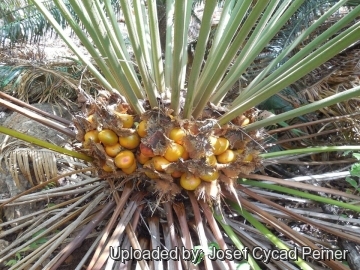 Cycas tansachana in Josef Cycad Perner Ex-situ Conservation collection. Photo by Cycad International. Photo by: Josef Cycad Perner
Cycas tansachana in Josef Cycad Perner Ex-situ Conservation collection. Photo by Cycad International. Photo by: Josef Cycad Perner Female Cone. Photo by: Josef Cycad Perner
Female Cone. Photo by: Josef Cycad Perner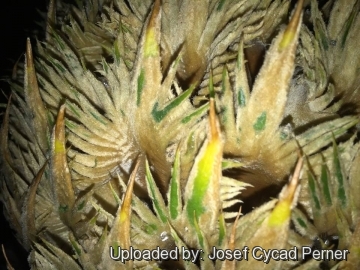 Yellow-tomentose to brown-tomentose megasporophylls. up to 20-22 cm long Photo by: Josef Cycad Perner
Yellow-tomentose to brown-tomentose megasporophylls. up to 20-22 cm long Photo by: Josef Cycad Perner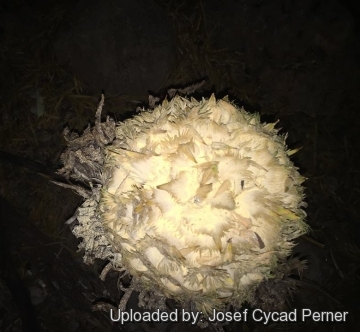 Female Cone covered in Pollen. Photo by: Josef Cycad Perner
Female Cone covered in Pollen. Photo by: Josef Cycad Perner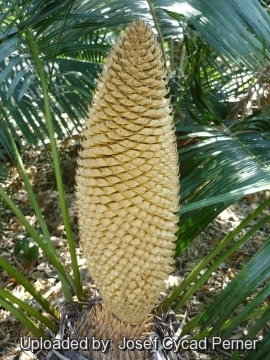 Cycad Cones in Joe's Cycad Gardens. Male cone. Photo by: Josef Cycad Perner
Cycad Cones in Joe's Cycad Gardens. Male cone. Photo by: Josef Cycad Perner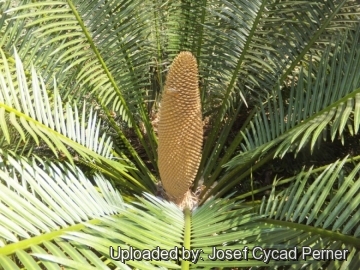 This was grown from seeds that I collected from Habitat on Cycad Research Expedition with Ken Hill. Photo by: Josef Cycad Perner
This was grown from seeds that I collected from Habitat on Cycad Research Expedition with Ken Hill. Photo by: Josef Cycad Perner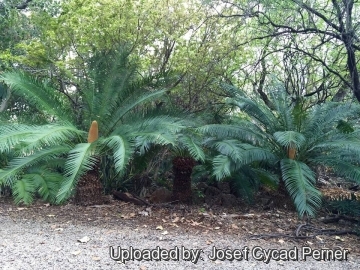 Cycas tansachana Photo by: Josef Cycad Perner
Cycas tansachana Photo by: Josef Cycad PernerSend a photo of this plant.The gallery now contains thousands of pictures, however it is possible to do even more. We are, of course, seeking photos of species not yet shown in the gallery but not only that, we are also looking for better pictures than those already present.
Read More... Cultivation and Propagation: Cycas tansachanaSN|11194]]SN|29483]] is suited to tropical regions which have a seasonally dry climate. It is easy to grow, tolerating dry periods. Queen Sago is often the focal point in a large yard. It is becoming more and more common and turning out to be a great landscape plant. It is attractive as a young plant because of the swollen base. Cycas tansachana is suited to pot culture.
Growth rate: It is a robust, fast-growing species, one of the fastest and easiest Cycas species. Because of its growth habit, fertilize only when terminal bud begins to swell, indicating the start of the annual growth cycle.
Exposure: It prefers bright light exposure but colour bleaches when in full sun; best with some protection from afternoon heat.
Soil: Needs a well drained spot, with deep soil, but will still thrive in less than ideal conditions.
Maintenance: Minimal; removal of offsets if desired, removal of spent fronds.
Hardiness: This species is probably a bit tropical in its needs, like Cycas siamensisSN|29483]]SN|11194]] from similar habitat, but turns out it is extremely frost tolerant growing very well and easily in Mediterranean climates. If plants will be encased in ice. They were not amused. The leaves dies but the plants just flushed out again. Cycads as a general rule are tough and these are no exception.
Use: Landscape as cultivated perennial in warm, coastal areas; House-plant or interior-scape, as container plant in cool areas, as well very well suited to bonsai culture.
Warning: Petiolar spines are short and well spaced, but still sharp so take care when pruning.
Propagation: Seed. As a slow growing plant, the seed can take from 6–18 months to germinate. After fertile seeds are collected, they usually need several months of storage before the inner embryo is ready to germinate. Therefore, it is best to clean the seeds of external fruit and set them aside before attempting to propagate the seeds. Usually seeds are ready to germinate after 2-4 month, the germination is rapid and almost all seeds germinate up within 2 month.
















